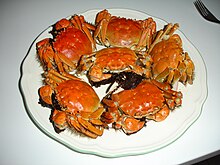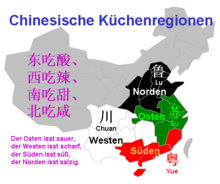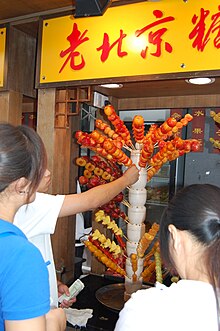Chinese regional cuisine
The Chinese cuisine is not homogeneous, but is divided into different Chinese regional cuisines . The most common is the division into four or five kitchens: Canton cuisine in southeast China , Fukien cuisine (east coast), Peking Shantung cuisine (northeast), Henan cuisine (center) and Sichuan Hunan Kitchen (west).
China's great dividing line in agricultural and nutritional terms lay between the catchment area of the Yellow River and the Yangtze River (see regions of China ). It separated the wheat and millet belt from the rice fields . China's ethnic groups have their own cuisine that draws on local produce and is shaped by various historical traditions. For example, dairy products are only known to some of the Central Asian ethnic groups (products made from mare's milk or yak milk). Bread to Persian style is throughout Xinjiang spread.
Peking cuisine
North Chinese cuisine is best known as Peking cuisine , but it has also been heavily influenced by Mongolia and Shandong . The Mongols introduced dishes made from mutton and lamb here, and Shandong is the source of the frequent use of garlic and onions as spices. In Beijing, in addition to the usual folk cuisine, there was the upscale cuisine of the ruling house, which is also known as Mandarin cuisine . Everyday North Chinese cuisine is considered to be the simplest and least demanding in China. In this climatically harsh region in particular, all available sources of food have always had to be exhausted and in the past there were repeated famines after bad harvests .
Rice could hardly be grown in northern China because of the climate , so wheat , soy and millet were the most important staple foods . Today corn has replaced millet, but is mainly used as fodder. Important vegetables are Chinese cabbage , cucumber and celery , and melons , especially watermelons , are also grown. The most popular meat is pork, as in the rest of China, but beef and lamb are also frequently eaten, as are chickens and ducks , although these are a specialty. Ginger , garlic, sesame oil and soy sauce are traditionally used for seasoning .
Typical dishes from the north are noodle soups and filled dumplings . Large dumplings of this type are called 包子 ( baozi ) and are dumpling- like, with a firm filling, while smaller 饺子 ( jiaozi ) have an individual filling that is not unlike that of Maultaschen. Grain soups used to be a common everyday food, especially millet porridge. An import from Iranian cuisine are small sesame breads called shaobing , known in Iran as nan and imported by Iranian refugees during the Tang Dynasty . Today they are often stuffed with meat in China. A specialty from Hebei is sweet and sour fish, mostly made from carp .
The most internationally famous dish in the region is the Peking duck ; The ducks are specially fattened for this dish. The preparation is very complex and is therefore mostly left to restaurants today. The so-called Eight Delicacies are a dish in the Mandarin cuisine , although the composition can vary. At the imperial court, this could also include camel humps, monkey lips and bear paws, but chicken, duck and fish as well as vegetables are more common.
Canton cuisine
South Chinese cuisine is often referred to abroad as canton cuisine ; Canton is an old western name of Guangdong , which was also used to designate the capital Guangzhou in western languages. This cuisine is the most internationally known Chinese culinary tradition and is the basis of most dishes that are offered in international Chinese restaurants. It is also highly regarded in China; the kitchens in Guangzhou and Hong Kong enjoy the best reputation . Western tastes are met by the fact that the dishes are not spicy. An important preparation method is wok cooking (stir-frying). Fresh ingredients are generally preferred.
The Guangdong region has the most developed agriculture and fisheries in China and is also the core area of rice cultivation. Several types of cabbage are grown as vegetables, as well as onions, garlic, lettuce , tomatoes , potatoes and soybeans, which are fermented as tau si and are an important basic ingredient in southern Chinese cuisine. Typical spices are ginger, spring onions , salt, vinegar, soy sauce and rice wine .
In southern China, more animal species are traditionally eaten than in other regions of China, a proverb translated as follows: “Any animal with its back facing the sun is edible.” In addition to beef, pork and chicken, this also includes snakes, insects, worms and sometimes dogs , whereby dog meat is mainly attributed medicinal properties. The inclusion of nutrition in traditional Chinese medicine plays an important role, especially in southern China. A lot of fresh fish is eaten on the coast, pork is the preferred type of meat inland, while poultry is mainly prepared on special occasions.
The most important staple food is rice. For the poorer population, rice with soy sauce was often the only meal of the day. A specialty of the region are soups that simmer for hours and take on the taste of the ingredients. Noodles are eaten cooked in broth or with vegetables and meat as a chow mein . For breakfast you usually have rice soup with tea. The main meal can take place at noon or in the evening and is always based on rice, often supplemented by steamed fish and stir-fried vegetables. A soup is usually served at the end. The second hot meal of the day is often noodle soup. On special occasions, dim sum is served as a starter, small filled dumplings.
Sichuan-Hunan cuisine
West Chinese cuisine is mainly found in the provinces of Sichuan , Hunan and Yunnan and is sometimes also called Sichuan cuisine . Sichuan is the 4th most populous province in China and is known as the country's “rice chamber”. Millet used to play an important role as a staple food. In the recent past, the cultivation of corn, potatoes and sweet potatoes has become very widespread.
The main characteristics of Western Chinese cuisine are the use of pickled vegetables, especially garlic, Chinese cabbage and bamboo shoots , and the spiciness of most dishes from the abundant use of chilli , white pepper and native Szechuan pepper (bot. Zanthoxylum piperitum ). This kitchen is considered the only one in the world that combines all available peppery spices in one dish. This preference for spiciness is already documented in very old sources and did not just emerge in modern times through the introduction of chilli from America. The use of dried mandarin peel as a spice is also characteristic .
Pork is by far the most popular type of meat. A very high quality ham is produced in Yunnan , the quality of which is compared to the Spanish Serrano ham . Sheep and goats are also kept, but cattle play a role primarily as draft animals and are rarely eaten. Yogurt is made by the Han Chinese in Yunnan , while most Chinese traditionally do not eat dairy products.
One of the best-known dishes in Western Chinese cuisine is sour and spicy soup ( suanlatang ), which is usually prepared from dried lily buds, mushrooms, bamboo shoots, thickened chicken or duck blood, sesame oil, wine vinegar, chilli, pepper and sometimes meat. Also known is the wok-cooked chicken with peanuts and dried mandarin peel, called 'Gong Bao Ji Ding'. A typical dish of the Sichuan cuisine that is known nationwide is Mapo Doufu . A duck dish is very well known, at least in China, in which the duck is cooked in the rising smoke of tea leaves and camphor . Tofu is also often eaten , which is heated in a wok and spicy.
Hunan's cuisine is similar to Sichuan's, but generally does not use Sichuan pepper. Fish and chicken play a bigger role. Yunnan's cuisine is simpler and shows influences from Southeast Asian cuisines, herbs and mushrooms play a major role. A specialty here is the preparation of vegetables and ham in burning oil in a wok in seconds. Yunnan is also an important tea growing area .
Jiangsu cuisine

Eastern Chinese cuisine encompasses several provinces on the Yangtze River Delta ; important cities are Shanghai , Suzhou , Hangzhou and Ningbo . It is hardly known outside of China. The cooking style is very labor-intensive, as the visual presentation of the dishes plays an important role. The region's staple foods are rice and wheat , and many vegetables and fruits are grown. A particularly large type of pear is known . The breeding of silkworms in mulberry tree plantations also plays an important role . The region is also known for high quality teas.
Meat is mainly supplied by pigs, chickens and ducks, while sheep and cattle hardly play a role. However, the most popular is fish. The Yangtze River is now polluted and overfished, which is why the breeding of fish and other marine animals in fish farms plays a major role today. Crabs and prawns are popular among others . Frogs and snails are also eaten in this area, something that was once ridiculed in other regions of China.
A hallmark of Eastern Chinese cuisine is its preference for the sweet taste and the abundant use of oil. So it is relatively difficult. A special cooking technique is "red boiling", cooking meat or fish in dark soy sauce and rice wine. Commonly used as spices are ginger, spring onions , rice wine and sugar. A main meal usually consists of rice and three or four dishes. Between meals are filled dumplings or noodle soups. The specialties include fish in a sweet and sour sauce, shrimp, frog legs and snail dishes. In addition, vegetarian dishes play an important role for the followers of Buddhism .
swell
- Article Beijing Cuisine in the Encyclopedia of Food and Culture
- Article Guangzhou Cuisine in the Encyclopedia of Food and Culture
- Article Szechuan Cuisine in the Encyclopedia of Food and Culture
- Article Zhejiang Cuisine in the Encyclopedia of Food and Culture



